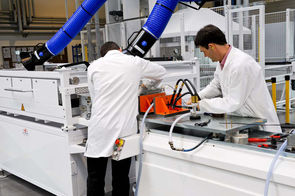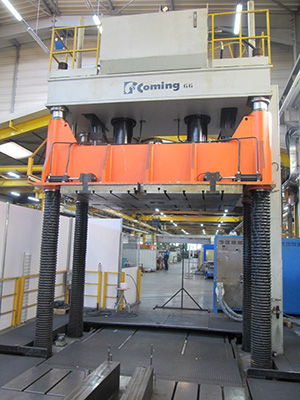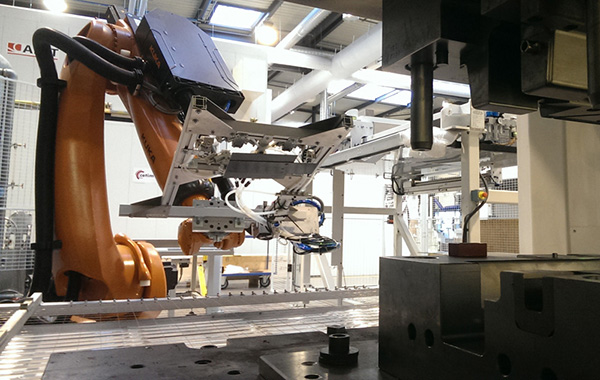Andy Pye looks at two innovations from Europe, the Quilted Stratum Process and Digimat-VA, both designed to hasten the progress of the composite industry into the high volume manufacturing arena. Visitors to The JEC Innovation Awards Ceremony – held on 2 June 2015 (6pm) at the JEC Americas Welcome Reception at The Grove, Houston, TX – will get an opportunity for an early view of both, as well as nine other highlighted projects.

While there are potential applications in aerospace and certain industrial sectors where volumes are modest, such as agricultural machinery, materials handling and lifting equipment, and heavy vehicles, the holy grail remains the use of composites for volume automotive parts. This has been hampered by the production rates of composites not being compatible with the needs of volume car manufacture. Automotive EOM and tier 1 suppliers are looking for cost-driven, structural lightweight parts with high production rates.
Now, the goal of CETIM’s Quilted Stratum Process is to develop a high-speed production line – cycle times of less than 90s from fiber to the finished product – for long fiber thermoplastic composites (glass, carbon) and hybrid composites. Continuous fibre-reinforced composites (CFRP) are increasingly being used in the aerospace and automotive industries to cope with weight challenges and meet high performance standards. Thanks to their unique combination of stiffness, strength and density, CFRPs open up new design possibilities.
The first two modules of the composite pilot line were a key exhibit at JEC Composites Exhibition (10-12 March 2015, Porte de Versailles in Paris). Taken together, these two modules form the cornerstone of the French national strategy on composite processing. The “Quilted Stratum Process” (QSP) stems from a partnership between Cetim and three French production process specialists – PEI Pinette, Compose and Loiretech. QSP has funding of EUR 4.8 million from the Pays de la Loire Region.

In the automotive and land transportation sectors, PEI Pinette supplies composite forming systems, most notably carbon fiber forming machinery, for both research and high volume production of components. Compose is an integrator of highly-efficient complete turnkey systems to manufacture composites or plastics parts. In 2013, Compose set up CT1 in a 600sq.m. state-of-the-art composite manufacturing facility equipped with RTM, hot forming, SMC and compression technologies.
Founded in 1988 as supplier of prototype moulds and parts for the automotive industry, Loiretech is based in Mauves Sur Loire in the West of France and designs and manufactures complete sets of tooling for large and complex composite, thermoplastic and metallic parts. It serves customers in commercial aerospace, automotive, defence and renewable energy.
The Fluid Resin Transfer Molding Thermoplastic Module represents an investment of about €14.7 million ($xx). It is coordinated by IRT Jules Verne (Advanced manufacturing, Nantes), IRT M2P (Matériaux, Métallurgie et Procédés, Metz), and CEMCAT, a technical centre located in the west of France dedicated to the improvement of advanced composite materials and processes for the transportation industry. CEMCAT works with companies including Renault, PSA, Airbus, Sotira, Hutchinson, as well as with public research organisations and educational institutions.
QSP allows parts to be made with variable thickness, custom multilayer reinforcement. It is possible to use multi-fiber and polymeric materials from pultruded hybrid bands. Production cycles for large volumes ranging from 40 to 90s, including preforming, heating, transfer and thermoforming/molding. Costs are competitive – the additional cost compared to conventional processing methods is estimated to be about EUR5 per kg saved (about x$/lb).

The mechanical strength envelope shows the local areas where there is anisotropy and the level of stress:
- For areas with high level of anisotropy, carbon fibers are usually used for high stiffness, with glass fibers or bio-sourced fibers for lower requirements
- For areas without anisotropy, steel, aluminum and magnesium can be used as well, depending on the level of stress
- For areas which require specific functionality, short -fiber reinforced polymers have a role.
“Faced with German competition, the French automobile industry decided to initiate in 2013 a national research program around materials,” said Stéphane Cassereau, CEO of IRT Jules Verne. “With the strong development of composites in the region of Pays Loire over a decade, the IRT Jules Verne and Cetim have played a pioneering role in this structure. To the automotive sector, the IRT is a credible alternative to Fraunhofer in Germany, which is also active in the same areas.”
Together with the Centre for Studies on Advanced Composite Materials for Transport (CEMCAT), discussions are now underway with the automotive industry to develop a production line – from fiber to end product – for composite thermoplastic continuous fibers (carbon, glass, etc.) and composite hybrids.
“To meet applicable emissions standards by 2020, it is imperative for manufacturers to reduce vehicle mass, which increases their interest in manufacturing structural composite parts,” says Christophe Champenois, Head of Composite Engineering at Cetim. “To accept a suppplementary cost of EUR 3/kg, automakers demand cycle times of under two minutes per piece.”
Materials testing
Another of the 11 highlighted projects is E-Xstream Engineering’s Digimat-VA – unique software for the accurate virtual characterization of composites. E-Xstream Engineering is owned by MSC Software and based in Hautcharage, Luxembourg.
There are many variables offered by any given composite material system – hundreds or even thousands of layup combinations can be conceived and tested. There is a need to reduce the amount of physical testing required to grasp the whole picture of a given material system.
Design feasibility is often dictated by the choice of laminate ply layup – carpet plots have proven to be great tools, but require extensive experimental testing. Physical testing of composite laminate coupons requires a huge amount of money and time, in addition to the associated waste of energy. This situation is hindering the acceleration of composites development in the aerospace and automotive industries, especially when new material systems come on stream.
Digimat-VA (standing for Virtual Allowables) starts with easy and efficient creation of advanced multi-scale material models (including micro-level variability) and FEA simulations of typical test coupons, and ending with dedicated automatic post-processing – which computes mean stiffness, strength and B-basis values (statistical values).
Generating a property distribution without extensive experimental work is now just a few clicks away and can define the allowable test matrix for any combination of CFRP materials, lay-ups, environment conditions and type of coupon tests, prepare and run the virtual tests, post-process results and generate a customized report.
It is powered by a non-linear FEA solver, coupled with the Digimat multi-scale modeling non-linear finite element solver and Digimat progressive failure modelling. Root cause analysis of early failure can now be understood thanks to the integrated variability modeling.
The views, opinions and technical analyses presented here are those of the author or advertiser, and are not necessarily those of ULProspector.com or UL Solutions. The appearance of this content in the UL Prospector Knowledge Center does not constitute an endorsement by UL Solutions or its affiliates.
All content is subject to copyright and may not be reproduced without prior authorization from UL Solutions or the content author.
The content has been made available for informational and educational purposes only. While the editors of this site may verify the accuracy of its content from time to time, we assume no responsibility for errors made by the author, editorial staff or any other contributor.
UL Solutions does not make any representations or warranties with respect to the accuracy, applicability, fitness or completeness of the content. UL Solutions does not warrant the performance, effectiveness or applicability of sites listed or linked to in any content.



Leave a Reply or Comment